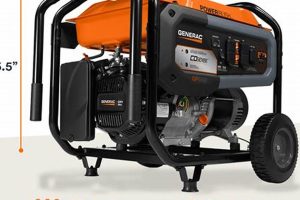Maintaining a power source during outages or off-grid activities often necessitates a functioning starting system. Small internal combustion engines, common in portable generators, require a battery to initiate operation. Over time, these batteries deteriorate, requiring replacement to ensure the generator starts reliably when needed. A typical scenario involves a user attempting to start their generator, only to find the engine cranks slowly or not at all, indicating a depleted or failing battery.
Reliable starting power is paramount for emergency preparedness and essential operations. A fresh battery ensures a generator can be quickly deployed when power is lost due to severe weather, grid failures, or when working in remote locations. Historically, generators relied on pull-starts, which can be challenging for some users. Electric starters powered by a healthy battery provide a more convenient and consistent starting experience, crucial in high-pressure situations. This ease of use can be life-saving during emergencies.
The following sections will delve into the specifics of selecting the correct replacement battery, the process of safely replacing it, and tips for maintaining battery health to maximize its lifespan and ensure reliable generator performance.
Tips for Effective Battery Management
Proper battery maintenance ensures reliable generator starting and extends battery lifespan. The following tips provide guidance for selecting, installing, and caring for a generator’s battery.
Tip 1: Choose the Correct Battery: Consult the generator’s owner’s manual for the recommended battery specifications. Using an incorrect battery can lead to starting problems or damage to the generator’s electrical system. Key specifications include voltage (typically 12V), amp-hour rating (Ah), and group size.
Tip 2: Disconnect Before Replacement: Before handling the battery, disconnect the negative cable first, followed by the positive cable. This prevents accidental short circuits and potential injury.
Tip 3: Inspect Cables and Terminals: Check for corrosion or damage on the battery cables and terminals. Clean corroded terminals with a wire brush and baking soda solution. Replace damaged cables as needed.
Tip 4: Securely Mount the Battery: Ensure the replacement battery is securely mounted in the generator’s battery tray to prevent movement during operation.
Tip 5: Connect Cables Correctly: Connect the positive cable to the positive terminal first, followed by the negative cable to the negative terminal. Ensure the connections are tight.
Tip 6: Periodically Charge the Battery: Generator batteries can discharge over time, especially during periods of inactivity. Use a battery charger to maintain a full charge, particularly if the generator is used infrequently.
Tip 7: Store Batteries Properly: If a battery is removed from the generator for storage, store it in a cool, dry place away from direct sunlight and extreme temperatures.
Adhering to these tips ensures optimal battery performance, prolongs battery life, and contributes to the generator’s overall reliability. These preventative measures offer significant long-term benefits by minimizing starting issues and reducing the need for frequent replacements.
By understanding the importance of battery maintenance and following these recommendations, users can ensure their generators are always ready to provide power when needed.
1. Battery Selection
Battery selection is a critical aspect of portable generator maintenance and directly impacts the effectiveness of a replacement. Choosing the correct battery ensures reliable starting, safeguards the generator’s electrical system, and maximizes the battery’s lifespan. An incorrectly chosen battery can lead to a range of issues, from starting failures and diminished performance to potential damage to the generator’s charging system. For example, using a battery with insufficient amperage may prevent the generator from starting, especially under load. Conversely, using a battery with excessive voltage could damage sensitive electronic components.
Several factors influence the selection process. The generator’s owner’s manual provides the most reliable information regarding the recommended battery specifications. Key parameters include voltage (typically 12 volts), amperage-hour (Ah) rating, and group size. The Ah rating reflects the battery’s capacity, influencing how long it can power the starter motor. The group size dictates the battery’s physical dimensions, ensuring it fits correctly in the generator’s battery compartment. Overlooking these parameters can have significant practical consequences. A battery with the wrong group size may not fit properly, while an inadequate Ah rating might leave the generator unable to start after extended periods of inactivity.
Successful portable generator battery replacement hinges on informed battery selection. Understanding the interplay between battery specifications and generator requirements ensures reliable operation and prevents potential damage. Careful consideration of these factors contributes significantly to the generator’s longevity and performance. Neglecting this crucial step can lead to frustrating starting problems, costly repairs, and potentially dangerous situations during power outages.
2. Safety Procedures
Safe battery replacement in portable generators is paramount to prevent accidents and ensure personal well-being. Overlooking safety precautions can lead to serious consequences, including electrical shocks, explosions, and fires. Therefore, adhering to established safety procedures is crucial for anyone undertaking this task.
- Disconnecting Power Sources
Before initiating any work on the generator, disconnect all power sources. This includes turning off the generator’s engine and disconnecting the spark plug wire. This critical step eliminates the risk of accidental starting during the replacement process, which could cause severe injury. For example, a sudden engine start could cause rotating parts to catch loose clothing or tools, leading to entanglement. Disconnecting the power safeguards against such scenarios.
- Personal Protective Equipment (PPE)
Utilizing appropriate PPE is essential for safe battery handling. This includes wearing insulated gloves and eye protection. Batteries contain corrosive acid that can cause burns and eye damage. Insulated gloves protect against electrical shocks and acid contact. Eye protection shields against potential splashes of battery acid or sparks generated during the replacement process. Failure to wear PPE can result in chemical burns, eye injuries, or electrical shocks.
- Ventilation
Batteries release hydrogen gas, which is highly flammable. Ensuring adequate ventilation during the replacement process helps dissipate this gas and prevents the risk of explosions. Working in a well-ventilated area, preferably outdoors, minimizes the buildup of hydrogen gas. In enclosed spaces, even a small spark can ignite accumulated hydrogen gas, causing a significant explosion. Proper ventilation significantly reduces this risk.
- Handling and Disposal
Handling batteries requires care to avoid short circuits and damage. Never touch both battery terminals simultaneously with metal tools. Dispose of old batteries responsibly at designated recycling centers or collection points. Improper handling can lead to short circuits, producing sparks and potentially igniting flammable materials. Likewise, incorrect disposal poses environmental risks due to the hazardous materials in batteries.
Implementing these safety measures minimizes the risks inherent in portable generator battery replacement. Careful adherence to these precautions safeguards against potential hazards, ensuring personal safety and preventing equipment damage. By prioritizing safety, individuals can confidently maintain their generators while minimizing risks.
3. Proper Installation
Proper battery installation is a critical step in portable generator maintenance, directly impacting the generator’s performance and longevity. A correctly installed battery ensures reliable starting, prevents electrical issues, and maximizes battery lifespan. Conversely, improper installation can lead to starting failures, damage to the generator’s electrical system, and potential safety hazards.
- Secure Mounting
Securing the battery firmly within its designated compartment prevents movement and vibration during operation. Loose connections caused by battery movement can interrupt power supply, leading to starting difficulties or system malfunctions. A loose battery can also sustain physical damage from impacts within the compartment. Employing brackets, straps, or other securing mechanisms as specified by the manufacturer ensures stability and prevents potential damage. For instance, a battery bouncing around in the compartment can damage terminals or internal components, shortening its lifespan and potentially causing leaks.
- Correct Cable Connections
Accurate cable connection is fundamental. Attaching the positive cable to the positive terminal and the negative cable to the negative terminal is crucial for proper electrical flow. Reversed polarity can damage the generator’s electrical components, including the charging system and control board, potentially leading to costly repairs. Moreover, a loose or corroded connection can restrict current flow, hindering starting performance. For example, a corroded negative terminal can prevent the generator from starting, even with a fully charged battery. Meticulous attention to clean and tight connections ensures optimal performance.
- Terminal Protection
Protecting battery terminals from corrosion safeguards against performance issues and extends battery life. Applying a dielectric grease or petroleum jelly to the terminals after connection creates a barrier against moisture and corrosive elements. This preventative measure ensures a consistent electrical connection and prevents the buildup of corrosion, which can impede current flow. A simple application of protective grease significantly extends the life and performance of the battery and its connections. Neglecting this step can lead to premature battery failure and starting problems.
- Post-Installation Verification
Verifying the installation’s integrity is essential. After installing the battery, starting the generator confirms proper functionality. This test validates the connections, ensures correct polarity, and confirms that the battery is adequately charged. Failure to start could indicate a loose connection, incorrect polarity, or a faulty battery. For instance, if the generator cranks slowly or not at all after installation, it suggests a problem with the connections or the battery itself. This check provides immediate feedback and allows for prompt rectification of any issues before relying on the generator during a power outage.
These facets of proper battery installation contribute significantly to the overall reliability and lifespan of a portable generator. Meticulous attention to these details ensures consistent starting performance, prevents electrical problems, and maximizes the return on investment. Overlooking these aspects can lead to avoidable failures, costly repairs, and potential safety risks, emphasizing the importance of proper installation in maintaining a dependable power source.
4. Testing Functionality
Testing functionality after a portable generator battery replacement is crucial for verifying the success of the replacement and ensuring the generator’s readiness for operation. This process confirms the integrity of the installation, the new battery’s performance, and the generator’s overall operational status. Neglecting this step can lead to unexpected failures during critical power outages, rendering the generator ineffective when needed most.
- Starting Test
The starting test is the most fundamental verification step. After installing the new battery, attempt to start the generator. A successful start indicates correct battery installation, adequate charge, and proper functioning of the starting system. A failure to start may signify issues such as loose or incorrect cable connections, a faulty battery, or problems with the generator’s starter motor. For example, a slow crank suggests a low battery charge or a poor connection, while no cranking at all might indicate a faulty starter or a completely discharged battery. This initial test provides immediate feedback on the basic functionality of the system.
- Load Test
Beyond simply starting, the generator must be able to handle the intended electrical load. Connect typical appliances or devices to the generator and observe its performance. The generator should maintain a steady voltage and frequency under load. Fluctuations, dimming lights, or stalling under load could indicate problems with the generator itself, separate from the battery replacement but crucial to diagnose after any maintenance. For instance, a generator struggling to power a refrigerator indicates a potential issue unrelated to the battery, requiring further investigation. This test validates the generator’s ability to perform its primary function.
- Runtime Test
Assessing runtime under load helps determine if the generator can sustain operation for the expected duration. This test involves running the generator under a typical load for an extended period, monitoring its fuel consumption and performance. A shorter-than-expected runtime might point to issues with the generator’s fuel system, engine efficiency, or other underlying mechanical problems. This test provides valuable insights into the generator’s overall health and fuel efficiency, ensuring preparedness for extended power outages. For example, a generator running out of fuel significantly faster than usual suggests a problem with the fuel system or engine efficiency. This test offers insights into long-term performance.
- Safety System Check
Modern generators often include safety features like low-oil shutdown and overload protection. Testing these systems ensures their proper functionality. Intentionally triggering these safety mechanisms confirms that they activate as designed, protecting the generator from damage. For instance, simulating a low-oil condition should automatically shut down the generator. A failure of these systems to activate poses a significant safety risk and can lead to irreversible engine damage. This final check confirms the operational integrity of essential safety components.
These tests, performed after a portable generator battery replacement, provide comprehensive validation of the generator’s operational readiness. They confirm the effectiveness of the battery replacement, identify any potential underlying issues, and ensure the generator’s ability to perform reliably during power outages. By diligently testing functionality, users can confidently rely on their generators when needed, mitigating the risks associated with unexpected failures.
5. Ongoing Maintenance
Ongoing maintenance plays a vital role in maximizing the lifespan and reliability of portable generator batteries, directly influencing the frequency of replacements. Regular maintenance mitigates the effects of aging and environmental factors, reducing the likelihood of premature failure and the need for frequent replacements. This proactive approach not only extends the operational life of the battery but also ensures the generator remains readily available during critical power outages. For example, consistently cleaning battery terminals and applying protective grease prevents corrosion, a common cause of reduced battery performance and premature failure. Similarly, periodic charging, especially during periods of inactivity, prevents deep discharge, which can significantly shorten battery life.
Several maintenance practices directly impact battery health. Maintaining proper electrolyte levels in flooded lead-acid batteries, ensuring adequate ventilation during operation, and storing the battery in a cool, dry environment contribute to its longevity. Neglecting these practices can accelerate battery degradation. For instance, operating a generator with low electrolyte levels can lead to sulfation, a condition that reduces the battery’s capacity and lifespan. Conversely, overcharging can lead to excessive gassing and water loss, also damaging the battery. Understanding these factors allows users to implement preventative measures, reducing the frequency of battery replacements and minimizing the associated costs and inconvenience. Storing a battery in extreme temperatures, whether hot or cold, can significantly impact its performance and lifespan, illustrating the practical significance of proper storage.
Effective ongoing maintenance significantly reduces the long-term costs associated with portable generator ownership by extending the intervals between battery replacements. Proactive maintenance also ensures the generator remains a reliable power source, ready when needed. This reliability is particularly crucial in emergency situations, where a functioning generator can be essential for safety and well-being. By understanding the direct link between ongoing maintenance and battery lifespan, users can make informed decisions about their generator care, ultimately saving money and ensuring reliable power availability.
Frequently Asked Questions
This section addresses common inquiries regarding portable generator battery replacement, providing concise and informative responses to clarify potential uncertainties.
Question 1: How often should a portable generator battery be replaced?
Battery lifespan varies depending on usage, maintenance, and environmental conditions. Typically, replacement is necessary every 2 to 4 years. Regular testing and inspection can help determine the need for replacement.
Question 2: Can any 12V battery be used as a replacement?
Using the correct battery type and specifications as recommended by the generator manufacturer is crucial. Incorrect battery selection can lead to starting problems or damage to the generator’s electrical system. Consulting the owner’s manual is essential.
Question 3: What are the signs of a failing portable generator battery?
Common signs include slow engine cranking, clicking sounds during starting attempts, dimming or flickering lights when the generator is under load, and a swollen or leaking battery case.
Question 4: Is it safe to replace a generator battery oneself?
Replacing a generator battery can be safely accomplished with proper precautions. Disconnecting the power source, wearing appropriate safety gear, and following the correct procedures are essential for safe replacement.
Question 5: How should an old generator battery be disposed of?
Disposing of old batteries responsibly at designated recycling centers or collection points is crucial. Improper disposal poses environmental risks due to the hazardous materials contained within batteries.
Question 6: How can battery lifespan be maximized?
Proper maintenance practices such as periodic charging, keeping the battery clean, and storing the battery in a cool, dry place can significantly extend its lifespan. Regularly inspecting and cleaning battery terminals helps prevent corrosion and maintain optimal performance.
Addressing these frequently asked questions provides a foundation for informed decision-making regarding portable generator battery replacement. Understanding these aspects contributes to the safe and effective maintenance of the generator, ensuring reliable power availability when needed.
For further information regarding specific generator models, consulting the manufacturer’s documentation is recommended.
Portable Generator Battery Replacement
Maintaining reliable power during outages or off-grid activities necessitates careful attention to portable generator maintenance, particularly battery replacement. This exploration has highlighted the critical aspects of this process, from selecting the correct battery and adhering to safety procedures during installation to testing functionality and implementing ongoing maintenance practices. Each step contributes significantly to the generator’s overall reliability and longevity, ensuring consistent performance when power is most crucial.
Investing time and effort in proper portable generator battery replacement translates to a dependable power source during unforeseen circumstances. Neglecting these essential maintenance practices can lead to inconvenient and potentially dangerous situations when power is unavailable. Proactive maintenance ensures preparedness and provides peace of mind, reinforcing the significance of proper battery care in maintaining a reliable power supply.






